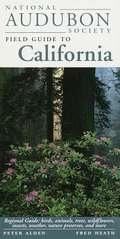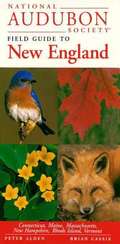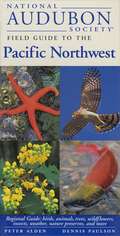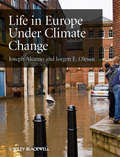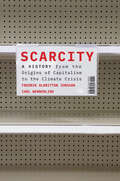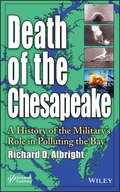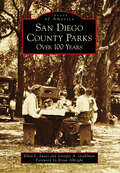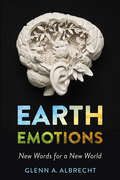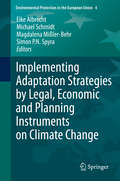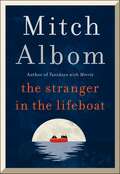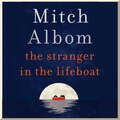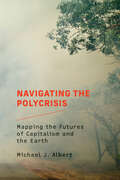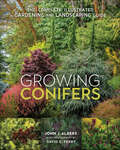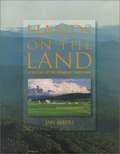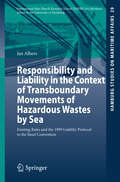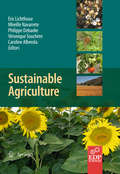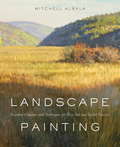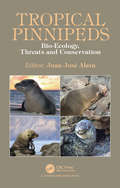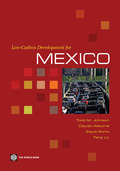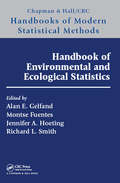- Table View
- List View
National Audubon Society Regional Guide To California (Audubon Society Regional Field Guides)
by Peter Alden National Audubon Society StaffFilled with concise descriptions and stunning photographs, the National Audubon Society Field Guide to California belongs in the home of every California resident and in the suitcase or backpack of every visitor. This compact volume contains: An easy-to-use field guide for identifying 1,000 of the state's wildflowers, trees, mushrooms, mosses, fishes, amphibians, reptiles, birds, butterflies, mammals, and much more; A complete overview of California's natural history, covering geology, wildlife habitats, ecology, fossils, rocks and minerals, clouds and weather patterns and night sky; An extensive sampling of the area's best parks, preserves, beaches, forests, islands, and wildlife sanctuaries, with detailed descriptions and visitor information for 50 sites and notes on dozens of others. The guide is packed with visual information -- the 1,500 full-color images include more than 1,300 photographs, 14 maps, and 16 night-sky charts, as well as 150 drawings explaining everything from geological processes to the basic features of different plants and animals. For everyone who lives or spends time in California, there can be no finer guide to the area's natural surroundings than the National Audubon Society Field Guide to California.
National Audubon Society Regional Guide To New England
by Peter Alden National Audubon Society StaffFilled with concise descriptions and stunning photographs, the National Audubon Society Field Guide to New England belongs in the home of every New England resident and in the suitcase or backpack of every visitor. This compact volume contains: An easy-to-use field guide for identifying 1,000 of the region's wildflowers, trees, mushrooms, mosses, fishes, amphibians, reptiles, birds, butterflies, mammals, and much more; A complete overview of New England's natural history, covering geology, wildlife habitats, ecology, fossils, rocks and minerals, clouds and weather patterns and night sky; An extensive sampling of the area's best parks, preserves, beaches, forests, islands, and wildlife sanctuaries, with detailed descriptions and visitor information for 50 sites and notes on dozens of others. The guide is packed with visual information -- the 1,500 full-color images include more than 1,300 photographs, 14 maps, and 16 night-sky charts, as well as 150 drawings explaining everything from geological processes to the basic features of different plants and animals. For everyone who lives or spends time in Connecticut, Maine, Massachusetts, Rhode Island, New Hampshire, or Vermont, there can be no finer guide to the area's natural surroundings than the National Audubon Society Field Guide to New England.
National Audubon Society Field Guide to the Pacific Northwest
by Peter Alden Amy Gregoret Daniel Mathews Dennis Paulson Richard Keen Eric A. Oches Robert Sundstrom Wendy B. ZomleferA complete overview of the Pacific Northwest's natural history, covering geology, wildlife habitats, ecology, fossils, rocks and minerals, clouds and weather patterns and night sky.
Life in Europe Under Climate Change
by Joseph Alcamo Jorgen E. OlesenLife in Europe will indeed go on as the climate changes, but not in the same way as before. The air will be warmer, winds will change, patterns of rainfall and snowfall will alter, and sea level is likely to rise. These phenomena are already being seen. Europe will in the future experience marked changes in vegetation cover, increased floods along rivers and coastlines as well as more frequent droughts and forest fires, often leading to large societal costs. The changes will be minor in some cases, profound in others, but in any case, pervasive. This book uses the most up to date information issued by the IPCC (Intergovernmental Panel on Climate Change), and informs readers about these effects, as well as showing how Europe is contributing to attempts to slow the tempo of global climate change, and how it can adapt to the climate change that seems unavoidable. Life in Europe under Climate Change makes essential information on climate impacts in Europe accessible to a broad audience, including students, politicians, planners and members of non-governmental organizations.
Scarcity: A History from the Origins of Capitalism to the Climate Crisis
by Fredrik Albritton Jonsson Carl WennerlindA sweeping intellectual history of the concept of economic scarcity—its development across five hundred years of European thought and its decisive role in fostering the climate crisis.Modern economics presumes a particular view of scarcity, in which human beings are innately possessed of infinite desires and society must therefore facilitate endless growth and consumption irrespective of nature’s limits. Yet as Fredrik Albritton Jonsson and Carl Wennerlind show, this vision of scarcity is historically novel and was not inevitable even in the age of capitalism. Rather, it reflects the costly triumph of infinite-growth ideologies across centuries of European economic thought—at the expense of traditions that sought to live within nature’s constraints.The dominant conception of scarcity today holds that, rather than master our desires, humans must master nature to meet those desires. Albritton Jonsson and Wennerlind argue that this idea was developed by thinkers such as Francis Bacon, Samuel Hartlib, Alfred Marshall, and Paul Samuelson, who laid the groundwork for today’s hegemonic politics of growth. Yet proponents of infinite growth have long faced resistance from agrarian radicals, romantic poets, revolutionary socialists, ecofeminists, and others. These critics—including the likes of Gerrard Winstanley, Dorothy Wordsworth, Karl Marx, and Hannah Arendt—embraced conceptions of scarcity in which our desires, rather than nature, must be mastered to achieve the social good. In so doing, they dramatically reenvisioned how humans might interact with both nature and the economy.Following these conflicts into the twenty-first century, Albritton Jonsson and Wennerlind insist that we need new, sustainable models of economic thinking to address the climate crisis. Scarcity is not only a critique of infinite growth, but also a timely invitation to imagine alternative ways of flourishing on Earth.
Death of the Chesapeake: A History of the Military's Role in Polluting the Bay
by Richard AlbrightIn essence this book deals with an area that contributes significantly to the pollution and degradation of Chesapeake Bay, but has been completely overlooked in many of the efforts to restore the Bay, specifically, the federal military pollution sources. The book also recognizes for the first time, that efforts to restore the Bay have failed because of violation of a fundamental precept of environmental cleanup; that is, to sample the site and see what is there. The Bay itself has never been sampled. Thus this book presents a view of the environmental condition of Chesapeake Bay that is totally unique. It covers a part of the history of the Bay that is not widely known, including how the Bay was formed. It presents a mixture of science, military history, and novel solutions to the Bay's degradation. In so doing, the author examines the military use of the Bay and reveals the extent of munitions dumpsites containing nitrogen and phosphorus as well as chemical warfare material, and how this is effecting the environment. The book concludes with the author's own clean-up plan that, if implemented, would go a long way to restoring health to Bay. The book is supplemented with many photographs and maps.
San Diego County Parks: Over 100 Years (Images of America)
by Brian Albright Ellen L. Sweet Jennifer A. GrahlmanFrom its earliest park in 1913, the County of San Diego has more than 100 years of serving the public with unique park and recreational experiences while preserving significant natural and cultural resources. Officially, the San Diego County Board of Supervisors established the Department of Recreation in 1946. Today, the department manages over 50,000 acres of parks, campgrounds, trails, recreation centers, sports complexes, and ecological and open-space preserves. The county covers an area that includes coastline, mountains, deserts, lakes, lagoons, and other habitats�it is the nation�s most biologically diverse county�and the department�s properties mirror this biodiversity. They also contain sites that reveal the county�s history: Mexican-era ranchos, an overland stage station, remnants of an early gristmill, Victorian mansions, traces of flume systems, Depression-era construction projects, an 1887 boathouse, and parks that reflect the advent of early automobile tourism.
Earth Emotions: New Words for a New World
by Glenn A. AlbrechtAs climate change and development pressures overwhelm the environment, our emotional relationships with Earth are also in crisis. Pessimism and distress are overwhelming people the world over. In this maelstrom of emotion, solastalgia, the homesickness you have when you are still at home, has become, writes Glenn A. Albrecht, one of the defining emotions of the twenty-first century.Earth Emotions examines our positive and negative Earth emotions. It explains the author's concept of solastalgia and other well-known eco-emotions such as biophilia and topophilia. Albrecht introduces us to the many new words needed to describe the full range of our emotional responses to the emergent state of the world. We need this creation of a hopeful vocabulary of positive emotions, argues Albrecht, so that we can extract ourselves out of environmental desolation and reignite our millennia-old biophilia—love of life—for our home planet. To do so, he proposes a dramatic change from the current human-dominated Anthropocene era to one that will be founded, materially, ethically, politically, and spiritually on the revolution in thinking being delivered by contemporary symbiotic science. Albrecht names this period the Symbiocene.With the current and coming generations, "Generation Symbiocene," Albrecht sees reason for optimism. The battle between the forces of destruction and the forces of creation will be won by Generation Symbiocene, and Earth Emotions presents an ethical and emotional odyssey for that victory.
Implementing Adaptation Strategies by Legal, Economic and Planning Instruments on Climate Change
by Eike Albrecht Michael Schmidt Magdalena Mißler-Behr Simon P. N. SpyraThe causes and effects of climate change are just as varied as the proposed solutions and approaches for dealing with the problem. Given the global character of climate change, comprehensive global cooperation is called for that leads to effective and appropriate international action in accordance with the respective responsibilities. These will inevitably differ depending on the capabilities and the social and economic situations of the respective actors. The contributions in this book present a variety of ideas, approaches and tools regarding the adaptation to climate change in specific countries and regions. In addition to examining (existing) legal instruments, they also focus on the implementation of economic instruments and planning tools, as well as their (further) development. Rather than simply discussing strategies to counteract climate change by reducing emissions, the authors also search for ways of actively adapting to climate change.
The Stranger in the Lifeboat
by Mitch AlbomThe stunning new novel from the bestselling author of global phenomenon Tuesdays with MorrieAdrift in a raft after a terrible shipwreck, ten strangers try to survive while they wait for rescue.After three days, short on water, food and hope, they spot a man floating in the waves.They pull him on board - and the survivor claims he can save them.But should they put their trust in him?Will any of them see home again?And why did the ship really sink?The Stranger in the Lifeboat is not only a deeply moving novel about the power of love and hope in the face of danger, but also a mystery that will keep you guessing to the very end.'Mitch Albom sees the magical in the ordinary' Cecelia Ahern'He has the ability to make you cry in spite of yourself' Boston Globe'Albom has touched the lives of a lot of people he never even knew' Time
The Stranger in the Lifeboat: The uplifting new novel from the bestselling author of Tuesdays with Morrie
by Mitch AlbomTHE INSTANT NO.1 NEW YORK TIMES BESTSELLERThe stunning new novel from the bestselling author of global phenomenon Tuesdays with Morrie'Mitch Albom sees the magical in the ordinary' Cecelia Ahern____________Adrift in a raft after a terrible shipwreck, ten strangers try to survive while they wait for rescue.After three days, short on water, food and hope, they spot a man floating in the waves.They pull him on board - and the survivor claims he can save them.But should they put their trust in him?Will any of them see home again?And why did the ship really sink?The Stranger in the Lifeboat is not only a deeply moving novel about the power of love and hope in the face of danger, but also a mystery that will keep you guessing to the very end.____________What real readers are saying about The Stranger in the Lifeboat: 'Enthralling storytelling as always from this brilliant writer' FIVE STARS 'Just when I thought I had things figured out . . . plot twist. One that was not expected. And another and another and another. Mind. Blown . . . You just just have to read it' FIVE STARS'Albom can always be depended on to not only write a book that is written well and entertaining, but compels the reader to look within themselves and feel something new' FIVE STARS'A very exciting, thrilling and poignant tale of trying to survive against the odds' FIVE STARS
Anxious Politics
by Bethany Albertson Gadarian Shana KushnerEmotions matter in politics - enthusiastic supporters return politicians to office, angry citizens march in the streets, a fearful public demands protection from the government. Anxious Politics explores the emotional life of politics, with particular emphasis on how political anxieties affect public life. When the world is scary, when politics is passionate, when the citizenry is anxious, does this politics resemble politics under more serene conditions? If politicians use threatening appeals to persuade citizens, how does the public respond? Anxious Politics argues that political anxiety triggers engagement in politics in ways that are potentially both promising and damaging for democracy. Using four substantive policy areas (public health, immigration, terrorism, and climate change), the book seeks to demonstrate that anxiety affects how we consume political news, who we trust, and what politics we support. Anxiety about politics triggers coping strategies in the political world, where these strategies are often shaped by partisan agendas.
Cute Kawaii Doodles
by Sarah AlbertoBursting with ideas for illustrators and those who have never sketched before, this inspirational book will teach you how to draw more than 100 adorable doodles and super-cute characters in just a few easy steps. Starting with a simple shape such as a circle or a square, Sarah Alberto - aka Doodles by Sarah - shows you how to transform these into a quirky plant, a cute donut, a characterful face, a dainty cloud, and much, much more.Annotated with quick tips and tricks to explain the process, the visual steps will show you how to create a whole host of charming characters, using the ubiquitous ballpoint pen. Why a ballpoint pen? It's universal, affordable, and versatile, and allows you to create small details and sharp lines. Sarah also demonstrates how you can also use coloured pencils or markers to add extra life to your completed doodles.With the author's engaging, sweet and simple style, you'll be instantly inspired to pick up a pen and some paper and doodle like you've never done before!
Navigating the Polycrisis: Mapping the Futures of Capitalism and the Earth
by Michael J. AlbertAn innovative work of realism and utopianism that analyzes the possible futures of the world-system and helps us imagine how we might transition beyond capitalism.The world-system of which we are all a part faces multiple calamities: climate change and mass extinction, the economic and existential threat of AI, the chilling rise of far-right populism, and the invasion of Ukraine, to name only a few. In Navigating the Polycrisis, Michael Albert seeks to illuminate how the &“planetary polycrisis&” will disrupt the global community in the coming decades and how we can best meet these challenges. Albert argues that we must devote more attention to the study of possible futures and adopt transdisciplinary approaches to do so. To provide a new form of critical futures analysis, he offers a theoretical framework—planetary systems thinking—that is informed by complexity theory, world-systems theory, and ecological Marxism. Navigating the Polycrisis builds on existing work on climate futures and the futures of capitalism and makes three main contributions. First, the book brings together modeling projections with critical social theory in a more systematic way than has been done so far. Second, the book shows that in order to grasp the complexity of the planetary polycrisis, we must analyze the convergence of crises encompassing the climate emergency, the structural crisis of global capitalism, net energy decline, food system disruption, pandemic risk, far-right populism, and emerging technological risks (e.g. in the domains of artificial intelligence, biotechnology, and nuclear weapons). And third, the book contributes to existing work on postcapitalist futures by analyzing the processes and mechanisms through which egalitarian transitions beyond capitalism might occur.A much-needed work of global futures studies, Navigating the Polycrisis brings together the rigor of the natural and social sciences and speculative imagination informed by science fiction to forge pathways to our possible global future.
Svalbard Imaginaries: The Making of an Arctic Archipelago (Arctic Encounters)
by Mathias Albert Dina Brode-Roger Lisbeth IversenBy drawing on a broad range of disciplinary backgrounds, this book illustrates the immense complexities of Svalbard as a place, point of reference, or social concept. It portrays the multiple, situated perspectives that characterize understandings and imaginings of Svalbard, and brings together contributions from academic fields that rarely interact with each other.Svalbard Imaginaries contributes to a number of research contexts, ranging from a broadly conceived, multi-disciplinary field of ‘Arctic Studies’ to more disciplinary specific debates on how places are reworked at the interstices of various global flows and vice versa. It assembles contributions on imaginaries that cover a wide array of issues, including—but not limited to—Svalbard as a geopolitical site, a landscape, an image, a (mining) heritage assemblage, a tourist destination, a wilderness, a built environment, a site of knowledge production, a site of artistic engagement, and projections of the future. It deliberately assembles analyses that refer to a variety of timescales and covers representations of the past, the present, and possible futures of Svalbard.
Guía de principiantes para Mano hecha en casa Recetas Desinfectantes: Recetas rápidas y fáciles para hacer tu Desinfectante de manos casero natural
by Jane AlbertEl desinfectante de manos commercial se está volviendo caro, y con la escasez de desinfectantes debido al COVID-19, es posible que debas recurrir a hacer el tuyo. Hacer tu propio desinfectante de manos es un proceso simple que resulta en una fórmula que puedes personalizar para satisfacer tus propios gustos. Los CCE (Centros de Control de Enfermedades) recomiendan lavarse las manos durante al menos 20 segundos varias veces al día, pero la realidad de la vida puede interponerse (en el camino, en un avión, tren o metro, entiendes el punto), y eso es cuando un desinfectante de manos es necesario. Si bien hay varias versiones de desinfectantes de manos sin alcohol en el mercado, los CCE recomiendan uno que contenga al menos 60% de alcohol para una máxima eficacia, y todos se venden en tiendas locales (al menos en Los Angeles) o por 10-20 veces su precio normal. Algnos desinfectantes de manos comerciales contienen ingredientes tan temibles como los gérmes de los que nos protegen, entonces, ¿por qué no hacer tu propio desinfectante de manos con los ingredientes que selecciones en unos pocos sencillos pasos? Aquí tienes una vista de lo que aprenderás: •Asuntos de Seguridad de los Desinfectantes para Manos •Efectividad de los Desinfectantes de Manos •Varias Recetas de Desinfectantes de Manos Caseros •Receta de la Organizacion Mundial de la Salud (OMS) para crearlo a base de alcohol para frotar •Como hacer Gel de Aloe Vera •Técnica Correcta de Lavado de Manos •Consejos del Uso Mas Eficiente de Desinfectante de Manos •!Y mucho más! Desplazate hacia arriba y haz click en el botón de "Comprar Ahora con 1-Click" para obtener tu copia !ya!
Guia Para Iniciantes de Receitas Caseiras de Antissépticos Para Mãos: Receitas fáceis e rápidas para fazer o seu próprio antisséptico caseiro e natural para mãos
by Jane AlbertO antisséptico para mãos comprado em lojas está ficando caro e, com a escassez dos higienizadores para mãos devido ao COVID-19, você pode ter que recorrer à fazer o seu próprio antisséptico. Fazer o seu próprio antisséptico para mãos é um processo simples que resulta em uma fórmula que você pode personalizar para adequá-la ao seu gosto pessoal. O CCD recomenda lavar as mãos várias vezes ao dia durante pelo menos 20 segundos, mas a realidade da rotina diária pode as vezes ser um empecilho (estar sempre em atividade, estar em um avião, trem ou metrô, você consegue compreender) — e é nesse momento que um antisséptico para mãos torna-se necessário. Ao tempo em que existem várias versões sem álcool de antissépticos para mãos no mercado, o CCD recomenda um antisséptico que contenha pelo menos 60% de álcool, para obter máxima eficácia — sem contar que todos estão esgotados nos estabelecimentos locais (pelo menos em Los Angeles) ou estão custando de 10 a 20 vezes o preço normal. Alguns dos antissépticos para mãos comercializados contêm ingredientes tão assustadores quanto os germes dos quais eles protegem, então por que não fazer o seu próprio antisséptico para mãos a partir dos ingredientes que você puder escolher, em apenas alguns fáceis passos. Aqui está uma prévia do que você aprenderá: • Preocupações de segurança dos antissépticos para mãos • Eficácia dos antissépticos para mãos • Várias receitas caseiras de antissépticos para mãos • Receita da Organização Mundial da Saúde (OMS) para fazer antissépticos para mãos à base de álcool • Como fazer gel de aloe vera • Técnica correta de lavagem das mãos • Dicas sobre como usar o antisséptico para mãos de forma eficiente • E muito mais! Role para cima e clique no botão "Compre agora com 1 clique" para obter sua cópia agora!
Growing Conifers: The Complete Illustrated Gardening and Landscaping Guide
by John J. AlbersEvergreen your landscape with the beauty and benefits of conifers Growing Conifers is a beautifully photographed, comprehensive gardening guide for selecting and cultivating conifers. Coverage includes:Conifer taxonomy, classification, and geographic distributionSelecting conifers for size, shape, color, and textureBest practices for placement and planting of trees, shrubs, and groundcovers in urban and rural gardensGrowing needs and low-input maintenanceBuilding healthy soil, minimizing water stress, and integrated pest managementBenefits of conifers including habitat, water and air quality, carbon sequestration, aesthetics, and food.Conifers are often overlooked in gardening and landscaping in favor of deciduous trees and shrubs. Yet conifers come in a wide variety of shapes, sizes, and colors and offer tremendous aesthetic and ecological benefits for any garden.Growing Conifers is an essential, comprehensive resource for gardeners and landscape professionals looking to develop beautiful, sustainable landscapes.-----------------------------------------------------------------------------New Society Publishers is an activist, solutions-oriented publisher focused on publishing books to build a more just and sustainable future. They pride themselves on holding the highest environmental standards of any publisher in North America. In 2002, they committed to printing all their books (including their full color books) on uncoated 100% post-consumer recycled paper, processed chlorine-free, with low-VOC vegetable-based inks. In doing so, the Growing Conifers' print run alone saved 66 fully grown trees, 5300 gallons of water, and 28,000 lbs of greenhouse gases. When you buy New Society Publishers' books, you are part of the solution!
Hands on the Land: A History of the Vermont Landscape
by Jan AlbersWinner of the annual Fred B. Kniffen Book Award presented by the Pioneer America Society (PAS). This award is given to the best new book published about the North American cultural landscape. Winner of a Vermont Book Professionals Association Milestone Award 2000, Winner of the National Arbor Day Foundation's 2001 Media Award and Winner of SPNEA's Book Prize for the year 2000 presented by the Society for the Preservation of New England Antiquities (SPNEA). This award is given to the book that best advances the understanding of the architecture, landscape and material culture of New England and the United States from the seventeenth century to the present published in 2000. In this book Jan Albers examines the history--natural, environmental, social, and ultimately human--of one of America's most cherished landscapes: Vermont. Albers shows how Vermont has come to stand for the ideal of unspoiled rural community, examining both the basis of the state's pastoral image and the equally real toll taken by the pressure of human hands on the land. She begins with the relatively light touch of Vermont's Native Americans, then shows how European settlers--armed with a conviction that their claim to the land was "a God-given right"--shaped the landscape both to meet economic needs and to satisfy philosophical beliefs. The often turbulent result: a conflict between practical requirements and romantic ideals that has persisted to this day. Making lively use of contemporary accounts, advertisements, maps, landscape paintings, and vintage photographs, Albers delves into the stories and personalities behind the development of a succession of Vermont landscapes. She observes the growth of communities from tiny settlements to picturesque villages to bustling cities; traces the development of agriculture, forestry, mining, industry, and the influence of burgeoning technology; and proceeds to the growth of environmental consciousness, aided by both private initiative and governmental regulation. She reveals how as community strengthens, so does responsible stewardship of the land. Albers shows that like any landscape, the Vermont landscape reflects the human decisions that have been made about it--and that the more a community understands about how such decisions have been made, the better will be its future decisions.
Responsibility and Liability in the Context of Transboundary Movements of Hazardous Wastes by Sea
by Jan AlbersThe term "hazardous wastes" covers a wide range of disused products and production wastes generated not only in industrial sectors, but also in all areas of everyday life. Hazardous wastes are to a large extent shipped by sea to third countries for recycling or disposal. While the procedural requirements for such movements are laid out in the 1989 Basel Convention, explicit rules of responsibility and liability for resulting damages are neither provided by the Basel Convention nor by other international conventions. The Liability Protocol to the Basel Convention of 1999 has not yet entered into force. This book examines the existing rules of responsibility and liability applying to States and private persons and outlines the conditions under which liability may be incurred. Subsequently, the advantages and shortcomings of the 1999 Liability Protocol are analyzed. Although this Protocol faces substantial political headwind, from a legal perspective it includes principally useful and reasonable approaches and should therefore be ratified.
Sustainable Agriculture
by Caroline Alberola Eric Lichtfouse Mireille Navarrete Philippe Debaeke Souchere VéroniqueSustainability rests on the principle that we must meet the needs of the present without compromising the ability of future generations to meet their own needs. Starving people in poor nations, obesity in rich nations, increasing food prices, on-going climate changes, increasing fuel and transportation costs, flaws of the global market, worldwide pesticide pollution, pest adaptation and resistance, loss of soil fertility and organic carbon, soil erosion, decreasing biodiversity, desertification, and so on. Despite unprecedented advances in sciences allowing to visit planets and disclose subatomic particles, serious terrestrial issues about food show clearly that conventional agriculture is not suited any longer to feed humans and to preserve ecosystems. Sustainable agriculture is an alternative for solving fundamental and applied issues related to food production in an ecological way. While conventional agriculture is driven almost solely by productivity and profit, sustainable agriculture integrates biological, chemical, physical, ecological, economic and social sciences in a comprehensive way to develop new farming practices that are safe and do not degrade our environment. In that respect, sustainable agriculture is not a classical and narrow science. Instead of solving problems using the classical painkiller approach that treats only negative impacts, sustainable agriculture treats problem sources. As most actual society issues are now intertwined, global, and fast-developing, sustainable agriculture will bring solutions to build a safer world. This book gathers review articles that analyze current agricultural issues and knowledge, then propose alternative solutions. It will therefore help all scientists, decision-makers, professors, farmers and politicians who wish to build a safe agriculture, energy and food system for future generations.
Landscape Painting (PE): Essential Concepts and Techniques for Plein Air and Studio Practice
by Mitchell AlbalaBecause nature is so expansive and complex, so varied in its range of light, landscape painters often have to look further and more deeply to find form and structure, value patterns, and an organized arrangement of shapes. In Landscape Painting, Mitchell Albala shares his concepts and practices for translating nature's grandeur, complexity, and color dynamics into convincing representations of space and light. Concise, practical, and inspirational, Landscape Painting focuses on the greatest challenges for the landscape artist, such as: • Simplification and Massing: Learn to reduce nature's complexity by looking beneath the surface of a subject to discover the form's basic masses and shapes.• Color and Light: Explore color theory as it specifically applies to the landscape, and learn the various strategies painters use to capture the illusion of natural light.• Selection and Composition: Learn to select wisely from nature's vast panorama. Albala shows you the essential cues to look for and how to find the most promising subject from a world of possibilities. The lessons in Landscape Painting—based on observation rather than imitation and applicable to both plein air and studio practice—are accompanied by painting examples, demonstrations, photographs, and diagrams. Illustrations draw from the work of more than 40 contemporary artists and such masters of landscape painting as John Constable, Sanford Gifford, and Claude Monet. Based on Albala's 25 years of experience and the proven methods taught at his successful plein air workshops, this in-depth guide to all aspects of landscape painting is a must-have for anyone getting started in the genre, as well as more experienced practitioners who want to hone their skills or learn new perspectives.
Tropical Pinnipeds: Bio-Ecology, Threats and Conservation
by Juan J. AlavaPinnipeds are a fascinating group of marine mammals that play a crucial role as apex predators and sentinels of the functioning and health of marine ecosystems. They are found in the most extreme environments from the Polar regions to the tropics. Pinnipeds are comprised of about 34 species, and of those at least 25% live permanently in tropical zones. This book reviews and updates current research on the biology, marine ecology, bio-monitoring, and conservation of tropical pinniped populations, including their behavior, anthropogenic stressors, and health. It also looks at challenges to be faced for the conservation of tropical pinnipeds, many of which are threatened species.
Low-Carbon Development for Mexico
by Claudio Alatorre Feng Liu Zayra Romo Todd M. JohnsonTo reduce the risk of climate change impacts it is necessary for the world to lower the carbon intensity of economic development. 'Low-Carbon Development for Mexico' estimates the net costs, greenhouse gas (GHG) emission reductions, and investment that would be needed to achieve a low-carbon scenario in Mexico to the year 2030. Among the key findings of the study are the following: Energy efficiency. Improving energy end-use efficiency in the industrial, residential, and public sectors is the least-cost option for reducing carbon emissions and can be achieved by accelerating current Mexican programs and policies. Supply efficiency and renewable energy. Mexico can lower the carbon intensity of the economy by improving the efficiency of energy supply in the electric power and petroleum industries, and by expanding the adoption of renewable energy technologies such as wind, biomass, small hydro, and geothermal. Public transport and vehicle fleet efficiency. Transport is the largest and fastest growing contributor of GHG emissions in Mexico, the majority of which comes from road transport. The greatest potential for reducing transport emissions lies with improving the quality and efficiency of urban transport, including more efficient vehicles and the design and organization of cities and public transport systems. Forestry - significant potential with large co-benefits. Measures to reduce emissions from deforestation and forest degradation (REDD), along with afforestation and commercial plantations, are among the largest GHG mitigation options in Mexico, and could provide numerous social and environmental benefits in rural areas. By undertaking a limited number of low-carbon interventions that are technologically and financially viable today, Mexico could hold carbon emissions relatively constant over the coming two decades while maintaining a vigorous rate of economic and social development. The costs of such a program would be relatively modest, but would require a range of regulatory and institutional changes to achieve, especially in the energy and transport sectors.
Handbook of Environmental and Ecological Statistics (ISSN)
by Alan Gelfand; Montse Fuentes; Jennifer A. Hoeting; Richard L. SmithThis handbook focuses on the enormous literature applying statistical methodology and modelling to environmental and ecological processes. The 21st century statistics community has become increasingly interdisciplinary, bringing a large collection of modern tools to all areas of application in environmental processes. In addition, the environmental community has substantially increased its scope of data collection including observational data, satellite-derived data, and computer model output. The resultant impact in this latter community has been substantial; no longer are simple regression and analysis of variance methods adequate. The contribution of this handbook is to assemble a state-of-the-art view of this interface. Features: An internationally regarded editorial team. A distinguished collection of contributors. A thoroughly contemporary treatment of a substantial interdisciplinary interface. Written to engage both statisticians as well as quantitative environmental researchers. 34 chapters covering methodology, ecological processes, environmental exposure, and statistical methods in climate science.
